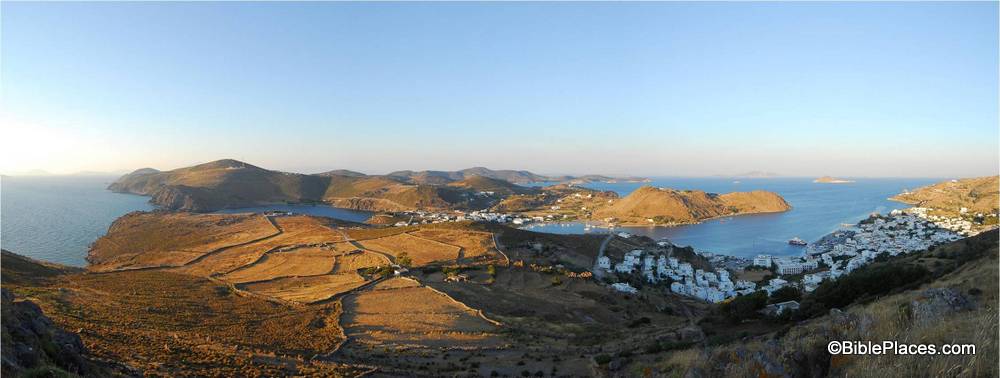This week’s photo focuses on what is arguably the last of the “Bible Places.” If the Garden of Eden is the first Bible Place, the island of Patmos could be considered the last.
Our picture of the week comes from Volume 12 of the revised and expanded version of the Pictorial Library of Bible Lands, which focuses on the Greek Islands. The photo is entitled “Patmos, View of Island North from Acropolis Panorama” (picture ID # tb061606331). If you have this volume, the photo can be found in the Microsoft PowerPoint presentation on Patmos. This photo is one of several beautiful panoramas that are available as part of the PLBL. (Click on the photo for a higher resolution.)
Why is this the last of the Bible Places? The small island of Patmos is where John received his heavenly visions which were later written down in the last book of the Bible: the book of Revelation. In Revelation 1:9 the apostle writes, “I, John, your brother and companion in the suffering and kingdom and patient endurance that are ours in Jesus, was on the island of Patmos because of the word of God and the testimony of Jesus” (ESV).
Patmos is a small island: only 7.5 miles long and 6 miles wide. To walk from one end to the other would take only a few hours. It is situated between modern Turkey and Greece, and is a volcanic island with rocky soil. The island was settled on and off throughout the centuries. During the Roman period, there is evidence that there was a temple to Artemis and a gymnasium there, so it is unlikely that John was alone during his stay. According to the notes in the PLBL, there have been over 300 churches built on the island over the last 2,000 years. With only 13 square miles of real estate, that means there has been an average of 23 churches per square mile!
 Mount Zion is mentioned in Revelation 14:1, but is this referring to the hill called Mount Zion during biblical times or the modern Mount Zion that was mislabeled by the Byzantines? Until the jury weighs in on that issue, Mount Zion is disqualified. “Babylon” is the focus of Revelation 17 and 18, but Bible scholars are divided about whether that refers to actual Babylon, to Rome, or to something else entirely, so that option should be ruled out. Some people probably would argue that the prize for the last Bible Place should be awarded to the new heaven and the new earth described in Revelation 21 and 22, but unfortunately John did not take any photographs for us and we can’t take tourists there, so that’s not really practical. So in the end, with our tongue planted firmly in our cheek, we award the illustrious prize of the last BiblePlace to the tiny (yet significant) island of Patmos!
Mount Zion is mentioned in Revelation 14:1, but is this referring to the hill called Mount Zion during biblical times or the modern Mount Zion that was mislabeled by the Byzantines? Until the jury weighs in on that issue, Mount Zion is disqualified. “Babylon” is the focus of Revelation 17 and 18, but Bible scholars are divided about whether that refers to actual Babylon, to Rome, or to something else entirely, so that option should be ruled out. Some people probably would argue that the prize for the last Bible Place should be awarded to the new heaven and the new earth described in Revelation 21 and 22, but unfortunately John did not take any photographs for us and we can’t take tourists there, so that’s not really practical. So in the end, with our tongue planted firmly in our cheek, we award the illustrious prize of the last BiblePlace to the tiny (yet significant) island of Patmos!